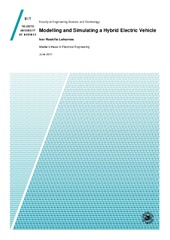| dc.contributor.advisor | Hoff, Bjarte | |
| dc.contributor.author | Leikarnes, Ivar Roskifte | |
| dc.date.accessioned | 2017-08-25T06:00:52Z | |
| dc.date.available | 2017-08-25T06:00:52Z | |
| dc.date.issued | 2017-06-12 | |
| dc.description.abstract | This thesis presents an overview of the different types of hybrid electric vehicle structures and basic guidelines regarding choice of components. The simulation model of a hybrid electric vehicle was created for this thesis to investigate the impact on fuel efficiency in relation to rolling resistance coefficient and vehicle weight. Although the model is not designed for optimal engine operation, the results indicate that lower rolling resistance coefficient and lower vehicle weight leads to reduced fuel consumption. Proposed improvements to the simulation design are presented in the report. | en_US |
| dc.identifier.uri | https://hdl.handle.net/10037/11371 | |
| dc.language.iso | eng | en_US |
| dc.publisher | UiT Norges arktiske universitet | en_US |
| dc.publisher | UiT The Arctic University of Norway | en_US |
| dc.rights.accessRights | openAccess | en_US |
| dc.rights.holder | Copyright 2017 The Author(s) | |
| dc.rights.uri | https://creativecommons.org/licenses/by-nc-sa/3.0 | en_US |
| dc.rights | Attribution-NonCommercial-ShareAlike 3.0 Unported (CC BY-NC-SA 3.0) | en_US |
| dc.subject.courseID | SHO6262 | |
| dc.subject | VDP::Teknologi: 500::Elektrotekniske fag: 540 | en_US |
| dc.subject | VDP::Technology: 500::Electrotechnical disciplines: 540 | en_US |
| dc.subject | Hybrid Electric Vehicle | en_US |
| dc.subject | Simulation, Simulink | en_US |
| dc.subject | Fuel Efficiency | en_US |
| dc.title | Modelling and simulating a hybrid electric vehicle | en_US |
| dc.type | Master thesis | en_US |
| dc.type | Mastergradsoppgave | en_US |


 English
English norsk
norsk
